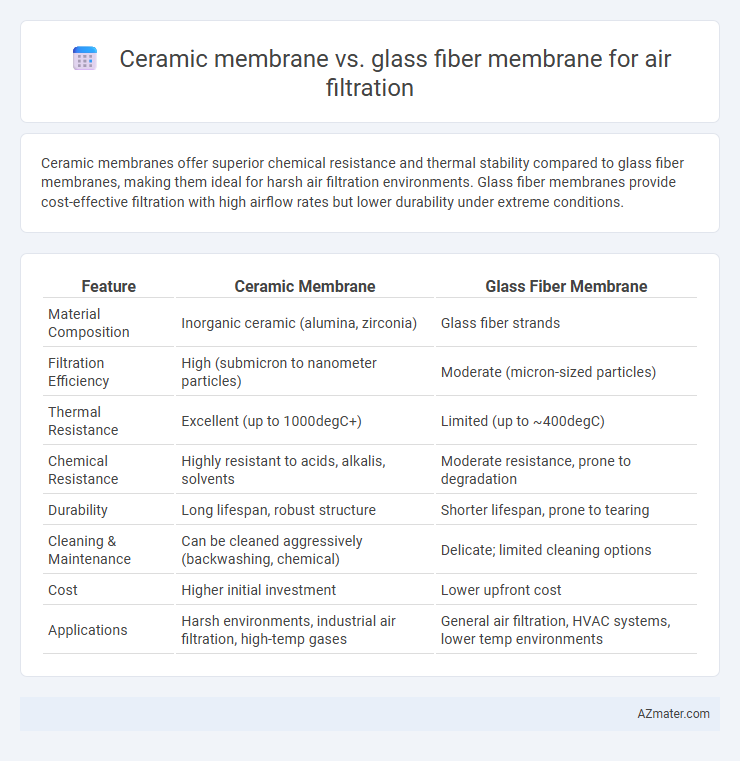Ceramic membranes offer superior chemical resistance and thermal stability compared to glass fiber membranes, making them ideal for harsh air filtration environments. Glass fiber membranes provide cost-effective filtration with high airflow rates but lower durability under extreme conditions.
Table of Comparison
| Feature | Ceramic Membrane | Glass Fiber Membrane |
|---|---|---|
| Material Composition | Inorganic ceramic (alumina, zirconia) | Glass fiber strands |
| Filtration Efficiency | High (submicron to nanometer particles) | Moderate (micron-sized particles) |
| Thermal Resistance | Excellent (up to 1000degC+) | Limited (up to ~400degC) |
| Chemical Resistance | Highly resistant to acids, alkalis, solvents | Moderate resistance, prone to degradation |
| Durability | Long lifespan, robust structure | Shorter lifespan, prone to tearing |
| Cleaning & Maintenance | Can be cleaned aggressively (backwashing, chemical) | Delicate; limited cleaning options |
| Cost | Higher initial investment | Lower upfront cost |
| Applications | Harsh environments, industrial air filtration, high-temp gases | General air filtration, HVAC systems, lower temp environments |
Introduction to Air Filtration Technologies
Ceramic membranes and glass fiber membranes represent two advanced materials used in air filtration technologies, each offering distinct benefits based on their composition and structure. Ceramic membranes provide exceptional thermal resistance, chemical stability, and fine particulate filtration suitable for high-temperature industrial applications, while glass fiber membranes excel in capturing larger airborne particles with high porosity and flexibility, making them ideal for HVAC and general air purification systems. Understanding the operational environment and specific filtration requirements is essential when selecting between ceramic and glass fiber membranes to optimize filtration efficiency and system longevity.
Overview of Ceramic Membranes
Ceramic membranes offer superior chemical resistance, high temperature tolerance, and excellent mechanical strength compared to glass fiber membranes, making them ideal for harsh industrial air filtration environments. Their microporous structure enables effective filtration of fine particles, ensuring high filtration efficiency and durability in demanding applications. Ceramic membranes also provide longer service life and lower maintenance requirements, reducing overall operation costs in air purification systems.
Overview of Glass Fiber Membranes
Glass fiber membranes offer high porosity and excellent mechanical strength, making them effective for capturing airborne particles in air filtration. Their fibrous structure enables efficient airflow while maintaining filtration efficiency, often used in HVAC systems and industrial applications. Compared to ceramic membranes, glass fiber membranes are cost-effective but less durable under extreme temperatures or chemical exposure.
Filtration Efficiency Comparison
Ceramic membranes exhibit superior filtration efficiency compared to glass fiber membranes due to their uniform pore size and high chemical resistance, effectively capturing particles as small as 0.01 microns. Glass fiber membranes typically show lower efficiency for fine particulate removal, often filtering particles above 0.3 microns with less durability under harsh conditions. Ceramic membranes also maintain consistent performance over time, making them ideal for applications requiring high precision and long-term stability in air filtration systems.
Mechanical Strength and Durability
Ceramic membranes exhibit superior mechanical strength and durability compared to glass fiber membranes, making them ideal for high-stress air filtration applications. The robust structure of ceramic membranes allows them to withstand high temperatures, abrasive particles, and chemical exposure without significant degradation. Glass fiber membranes, while cost-effective and flexible, are more prone to wear, tear, and damage under harsh operating conditions, resulting in shorter service life and increased maintenance needs.
Temperature and Chemical Resistance
Ceramic membranes exhibit superior temperature resistance, often withstanding continuous exposure above 900degC, making them ideal for high-temperature air filtration applications. In comparison, glass fiber membranes typically tolerate temperatures up to 450degC but degrade faster under thermal stress. Chemically, ceramic membranes resist aggressive gases and corrosive environments due to their inert composition, while glass fiber membranes show moderate chemical resistance but can deteriorate when exposed to strong acids or alkalis.
Maintenance and Lifespan
Ceramic membranes offer superior durability and longer lifespan compared to glass fiber membranes, withstanding higher temperatures and chemical exposure without degradation. Maintenance for ceramic membranes is less frequent and primarily involves gentle cleaning to preserve their structural integrity, whereas glass fiber membranes require regular replacement due to fiber erosion and clogging. The enhanced robustness of ceramic membranes results in reduced downtime and lower lifecycle costs in air filtration systems.
Cost Analysis and Economic Considerations
Ceramic membranes typically have higher upfront costs due to advanced materials and manufacturing processes but offer longer lifespan and superior chemical and thermal resistance, reducing replacement frequency and maintenance expenses. Glass fiber membranes are generally more affordable initially and suitable for lower-temperature applications, but they may require more frequent replacement and generate higher operational costs over time due to lower durability. Evaluating the total cost of ownership includes factoring in lifespan, energy efficiency, maintenance frequency, and application-specific requirements, where ceramic membranes often provide better long-term economic value despite higher initial investment.
Environmental Impact and Sustainability
Ceramic membranes offer superior environmental benefits for air filtration due to their high durability, long lifespan, and ability to withstand harsh cleaning processes without degradation, reducing waste and replacement frequency. Glass fiber membranes, while cost-effective and efficient in particulate capture, tend to generate more waste over time because of their limited durability and susceptibility to damage, leading to frequent disposal and environmental burden. The sustainable choice often favors ceramic membranes for their recyclability and lower long-term environmental footprint despite higher initial production energy costs.
Application Scenarios and Industry Suitability
Ceramic membranes excel in high-temperature, corrosive gas filtration and are ideal for industries such as chemical processing, power generation, and waste incineration due to their thermal stability and chemical resistance. Glass fiber membranes are better suited for general air filtration in HVAC systems, cleanrooms, and dust collection in manufacturing plants because of their affordability and efficient particulate capture. Selection depends on operational conditions; ceramic membranes withstand harsh environments while glass fiber membranes provide cost-effective, moderate-efficiency filtration for less demanding applications.

Infographic: Ceramic membrane vs Glass fiber membrane for Air filtration
 azmater.com
azmater.com